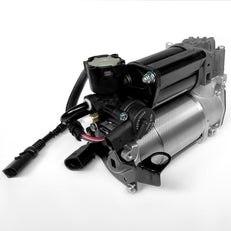Air suspension is a sophisticated system that utilizes air-filled bags instead of traditional coil springs to support a vehicle's weight. This innovative technology has gained popularity in both passenger and commercial vehicles due to its numerous advantages. In this article, we will delve into how air suspension works and why it can be a beneficial upgrade for your vehicle.

Understanding Air Suspension
At its core, air suspension consists of air springs, which are flexible rubber bags filled with compressed air. These air springs replace the conventional metal springs found in standard suspension systems. When the vehicle's weight is applied, the air springs compress, allowing for a smoother ride. But how does this system manage to provide such comfort?
- Adjustable Ride Height: One of the key features of air suspension is its ability to adjust the ride height. This means that drivers can raise or lower their vehicle depending on the terrain or driving conditions.
- Improved Load Handling: Air suspension systems can automatically adjust to the load being carried, ensuring that the vehicle remains level and stable.
- Enhanced Comfort: By absorbing shocks and vibrations more effectively than traditional systems, air suspension provides a more comfortable driving experience.
How Air Suspension Works
The operation of air suspension is relatively straightforward. When the vehicle is loaded, sensors detect the weight and adjust the air pressure within the air springs accordingly. This process is controlled by an onboard computer that continuously monitors the vehicle's height and makes real-time adjustments. If the vehicle encounters bumps or dips, the air suspension system compensates by redistributing air to maintain a consistent ride height.
But what happens if the air suspension system fails? In such cases, the vehicle may experience a rough ride, and the driver may notice a significant drop in handling performance. Regular maintenance and inspections are crucial to ensure the longevity of the system.
Benefits of Air Suspension
Investing in an air suspension system can offer several benefits:
- Versatility: Air suspension systems are suitable for various vehicles, including trucks, SUVs, and luxury cars.
- Improved Safety: By maintaining a level ride height, air suspension enhances vehicle stability, especially when cornering or carrying heavy loads.
- Customizable Experience: Drivers can adjust the suspension settings to suit their preferences, whether for comfort or performance.
Conclusion
In conclusion, air suspension is a remarkable advancement in automotive technology that provides enhanced comfort, safety, and versatility. If you're considering upgrading your vehicle's suspension system, explore options available at  air suspensions">. Understanding how air suspension works and its benefits can help you make an informed decision that enhances your driving experience.
air suspensions">. Understanding how air suspension works and its benefits can help you make an informed decision that enhances your driving experience.








